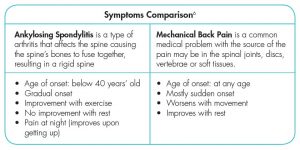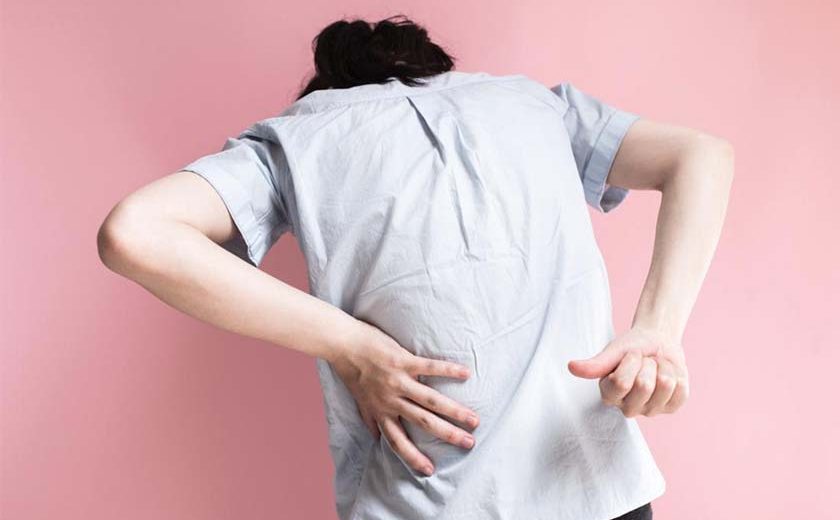Ankylosing spondylitis (AS) is a painful, progressively debilitating inflammatory disease. It is caused by inflammation of the spine leading to irreversible damage that significantly reduces patients’ mobility and quality of life.1
Globally, AS occurs in approximately 1% of the general population and typically affects young men and women in their teens and 20s. 2,3 Furthermore, it affects more males than females, with an approximate ratio of 2:1.2, 3
What are the symptoms of ankylosing spondylitis?
Ankylosing spondylitis is a systemic disease, which means symptoms may not be limited to the joints. Patients with the condition might experience fever, fatigue, and loss of appetite. Eye inflammation (redness and pain) occurs in some patients with spondylitis. In rare cases, lung and heart problems might develop.4
The areas that are most commonly affected includes5
- The joint between the base of spine and pelvis;
- Vertebrae in the lower back;
- The places where tendons and ligaments attach to bones, mainly in the spine, but sometimes along the back of the heel;
- The cartilage between breastbone and ribs;
- Hip and shoulder joints.
One of the most common symptoms that differentiate ankylosing spondylitis pain and mechanical back pain is patient can feel improvements of their condition with exercise and no improvement with rest.6

What is the immune system’s role in ankylosing spondylitis?
The immune system produces certain proteins called cytokines, which serve as “messengers” that coordinate communication between immune cells in response to an infection.7 One of these cytokines, interleukin-17A (IL-17A), has been identified as playing a key role in a number of immune-mediated diseases such as ankylosing spondylitis.7
Higher concentrations of IL-17A have been found in areas surrounding the bones and joints in patients suffering from ankylosing spondylitis, particularly in the fluid and lining of the joints.8,9,10
- IL-17A acts as signal to infection-fighting cells, triggering an inflammatory response that results in bone erosion and new bone formation to replace lost elastic tissue in areas surrounding the bones and joints.8,9,10
- Infection-fighting cells continue to release IL-17A, leading to further inflammation and ultimately new bone reformation that causes bones to grow together into a rigid structure. 8,9,10
What are the physical and psychological effects of ankylosing spondylitis?
Up to 70% of patients with severe AS can develop spinal fusion (bones grow together), which significantly reduces mobility and quality of life.1,11,12 Professional performance is significantly affected, with 78% more likely to shorten their working hours and therefore are at risk of losing their jobs.12 Because AS patients are unable to effectively undertake day-to-day activities, they may develop anxiety and depression.12
What are the unmet treatment needs in ankylosing spondylitis?
The diagnosis of ankylosing spondylitis is based on several factors including symptoms, findings from a physical exam, x-rays of the back and pelvis, measurements of the chest when breathing and results of lab tests.13 The condition does not follow the same course for everyone.14 In the early stages, the symptoms may come and go, but for most patients, the symptoms ultimately become more persistent.14
As of now, ankylosing spondylitis patients have very few therapeutic options available to them.15 For patients who do not respond to non-steroidal anti-inflammatory drugs (NSAIDS), anti-TNF (tumor-necrosis-factor) medicines are the only currently available biologic treatment alternative, but are not effective.15 Up to 40% of patients receiving anti-TNF therapy, the current standard of treatment for more severe disease, fail to achieve sufficient clinical improvement.15 The significant unmet need in ankylosing spondylitis is for safer, faster-acting and longer-lasting treatments than those currently available.15
There is no known cure for ankylosing spondylitis.14 However, there are treatments and medication that can reduce symptoms and manage pain.14 Furthermore, the ankylosing spondylitis condition can be controlled or minimized by regular mobilizing exercises, good posture, and proper medication.14
1 Sieper J, Braun J, Rudwaleit M, et al. Ankylosing spondylitis: an overview. Ann Rheum Dis. 2002;61(Suppl III):iii8-iii18.
2 WebMD, Back Pain Health Center, Arthritis and Ankylosing Spondylitis, [Accessed on: 1 December 2016], Available at: http://www.webmd.com/back-pain/guide/ankylosing-spondylitis#1
3 Akkoç, Nurullah et al. “Direct And Indirect Costs Associated With Ankylosing Spondylitis And Related Disease Activity Scores In Turkey”. Rheumatology International 35.9 (2015): 1473-1478.
4 NHS, Ankylosing spondylitis – Symptoms, [Accessed on: 1 July 2016], http://www.nhs.uk/Conditions/Ankylosing-spondylitis/Pages/Symptoms.aspx
5 Mayo Clinic, Ankylosing spondylitis, Symptoms, [Accessed on: 1 July 2016], http://www.mayoclinic.org/diseases-conditions/ankylosing-spondylitis/basics/symptoms/con-20019766
6 Harris, Claire et al. “Differentiating Inflammatory and Mechanical Back Pain”. Physiotherapist Module 1. August 2015
7 Patel DD, Lee DM, Kolbinger F, et al. Effect of IL-17A blockade with secukinumab in autoimmune diseases. Ann Rheum Dis. 2012.
8 Noordenbos T, Yeremenko N, Gofita I, et al. Interleukin-17-positive mast cells contribute to synovial inflammation in spondyloarthritis. Arthritis Rheum. 2012;64:99-109.
9 Taylan A, Sari I, Kozaci DL, et al. Evaluation of the T helper 17 axis in ankylosing spondylitis. Rheumatol Int. 2012;32:2511-2515.
10 Mei Y, Pan F, Gao J, et al. Increased serum IL-17 and IL-23 in the patient with ankylosing spondylitis. Clin Rheumatol. 2011;30:269-273.
11 Lories R. The balance of tissue repair and remodeling in chronic arthritis. Nat Rev Rheumatol. 2011;7:700-07.
12 Barkham N, Kong KO, & Tennant A. The unmet need for anti-tumour necrosis factor (anti-TNF) therapy in ankylosing spondylitis. Rheumatology. 2005;44:1277-81.
13 Diaplasis.eu, Arthritis and Ankylosing Spondylitis, [Accessed on: 7 February 2017], Available at: http://www.diaplasis.eu/en/175/
14 Arthritis Foundation of Malaysia, Ankylosing spondylitis, [Accessed on: 7 February 2017], Available at: http://afm.org.my/wp/?p=168
15 Dougados M, Baeten D. Spondyloarthritis. Lancet. 2011; 377:2127-37.
This article is brought to you by Arthritis Foundation Malaysia and Novartis Pharmaceuticals


